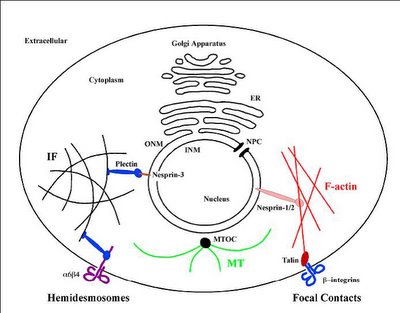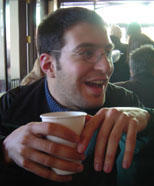Differentiation within organelles
Non-cell biologists have often viewed the cell as a bag of molecules. Over the years as cell-biology has developed, it became clear that this was a simplistic generalization. Cells are organized by a dynamic cytoskeletal network that can organize the cellular architecture. Cells are also subdivided into membrane bound organelles. The deeper we look into the cell the more we find that each cellular component is subdivided into specialized regions.

Now it would seem that organelles themselves are subdivided. As all good cell biologists know, the endoplasmic reticulum (ER) is a large continuous network of tubes and sheets responsible for synthesizing secreted protiens, metabiolize lipids and store calcium. Part of the ER extends and wrap around the nucleus to form the nuclear membrane. The inner nuclear membrane (INM) and outer nuclear membranes (ONM) are connected by specialized pores (nuclear pore complexes; NPCs) that allow only certain proteins to enter/exit the nucleus. The INM contains a specialized group of proteins that regulate several aspects of nuclear function.
I’ve been reading recent work on a group of proteins called Nesprins that localize exclusively to the ONM. Nesprins are some of the biggest proteins made by the cells. The nesprin proteins are anchored to the outer nuclear membrane by one end of the molecule, called the KASH domain. This domain extends across the the space between the outer and inner membranes (called the perinuclear space) to bind to a group of inner nuclear membrane proteins called SUNs. The other Nesprin end binds to various cytoskeletal elements and probably mediates how the Nucleus gets dragged around the cell. It looks like other proteins have KASH domains as well and may define an entire fauna of proteins that reside on the nuclear surface. So the outer nuclear membrane is further subdivided from the rest of the ER. There is the great spatial complexity that lies within cells, and we’ve only scratched the surface (I know corny pun).
Refs: Worman, H and Gundersen, G. Here come the SUNs: a nucleocytoskeletal missing link. Trends Cell Biol. 2006 (E-Published)
Update ... some trivia!
So it looks like Nesprins are some of the biggest proteins in the cell. Nesprins are members of the plakin family, all of which are huge. Here is a list of some of the biggest proteins encoded in the human genome (# of amino acids in parenthacies).
Some big proteins:
Giantin (3259)
Titin (33423)
Some plakins:
Nesprin-1 (8797)
Nesprin-2 (6883)
Nesprin-3 (975)
MACF (7412)
Dystonin (5497)
Plectin (4684)

Now it would seem that organelles themselves are subdivided. As all good cell biologists know, the endoplasmic reticulum (ER) is a large continuous network of tubes and sheets responsible for synthesizing secreted protiens, metabiolize lipids and store calcium. Part of the ER extends and wrap around the nucleus to form the nuclear membrane. The inner nuclear membrane (INM) and outer nuclear membranes (ONM) are connected by specialized pores (nuclear pore complexes; NPCs) that allow only certain proteins to enter/exit the nucleus. The INM contains a specialized group of proteins that regulate several aspects of nuclear function.
I’ve been reading recent work on a group of proteins called Nesprins that localize exclusively to the ONM. Nesprins are some of the biggest proteins made by the cells. The nesprin proteins are anchored to the outer nuclear membrane by one end of the molecule, called the KASH domain. This domain extends across the the space between the outer and inner membranes (called the perinuclear space) to bind to a group of inner nuclear membrane proteins called SUNs. The other Nesprin end binds to various cytoskeletal elements and probably mediates how the Nucleus gets dragged around the cell. It looks like other proteins have KASH domains as well and may define an entire fauna of proteins that reside on the nuclear surface. So the outer nuclear membrane is further subdivided from the rest of the ER. There is the great spatial complexity that lies within cells, and we’ve only scratched the surface (I know corny pun).
Refs: Worman, H and Gundersen, G. Here come the SUNs: a nucleocytoskeletal missing link. Trends Cell Biol. 2006 (E-Published)
Update ... some trivia!
So it looks like Nesprins are some of the biggest proteins in the cell. Nesprins are members of the plakin family, all of which are huge. Here is a list of some of the biggest proteins encoded in the human genome (# of amino acids in parenthacies).
Some big proteins:
Giantin (3259)
Titin (33423)
Some plakins:
Nesprin-1 (8797)
Nesprin-2 (6883)
Nesprin-3 (975)
MACF (7412)
Dystonin (5497)
Plectin (4684)


<< Home